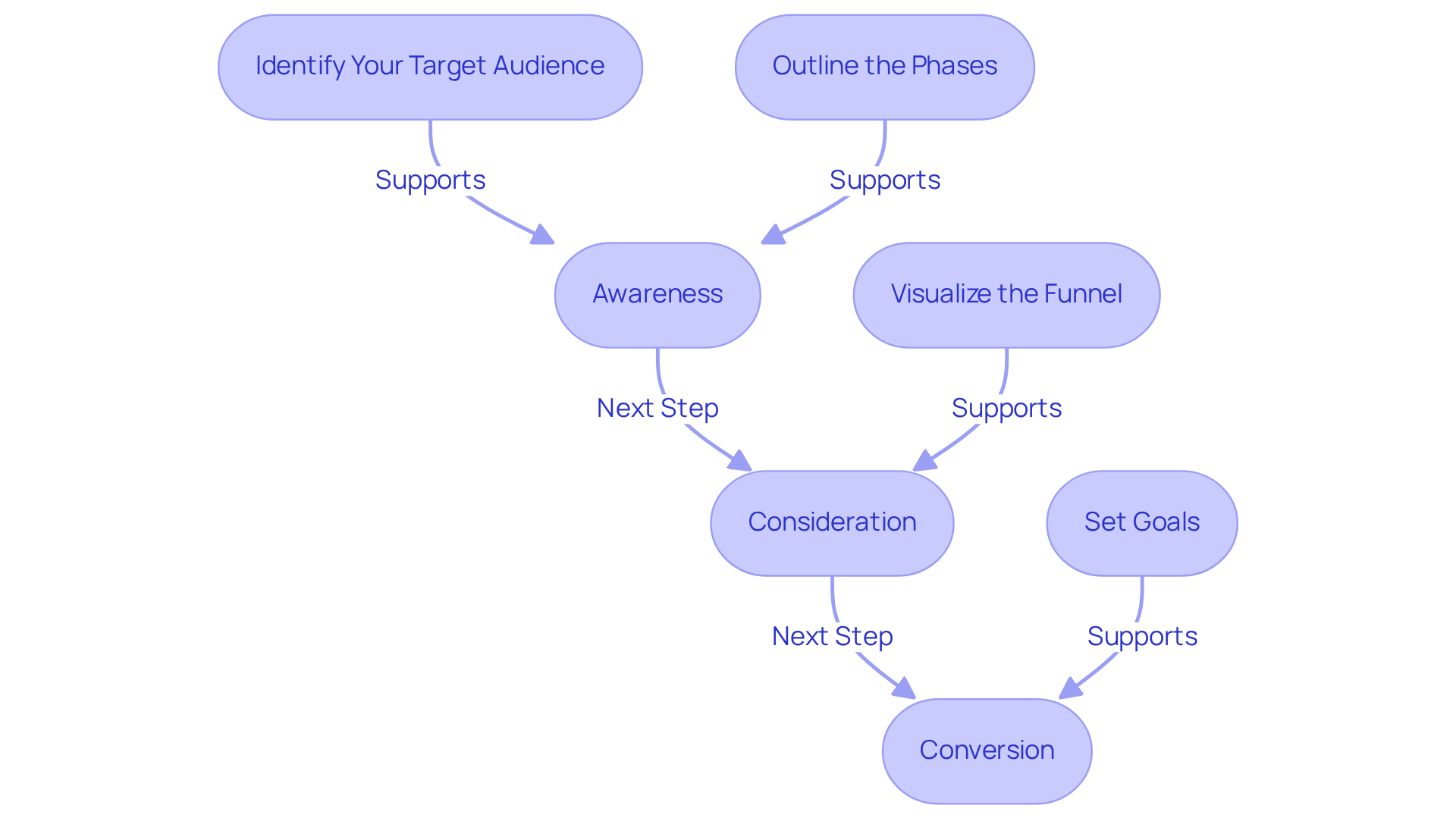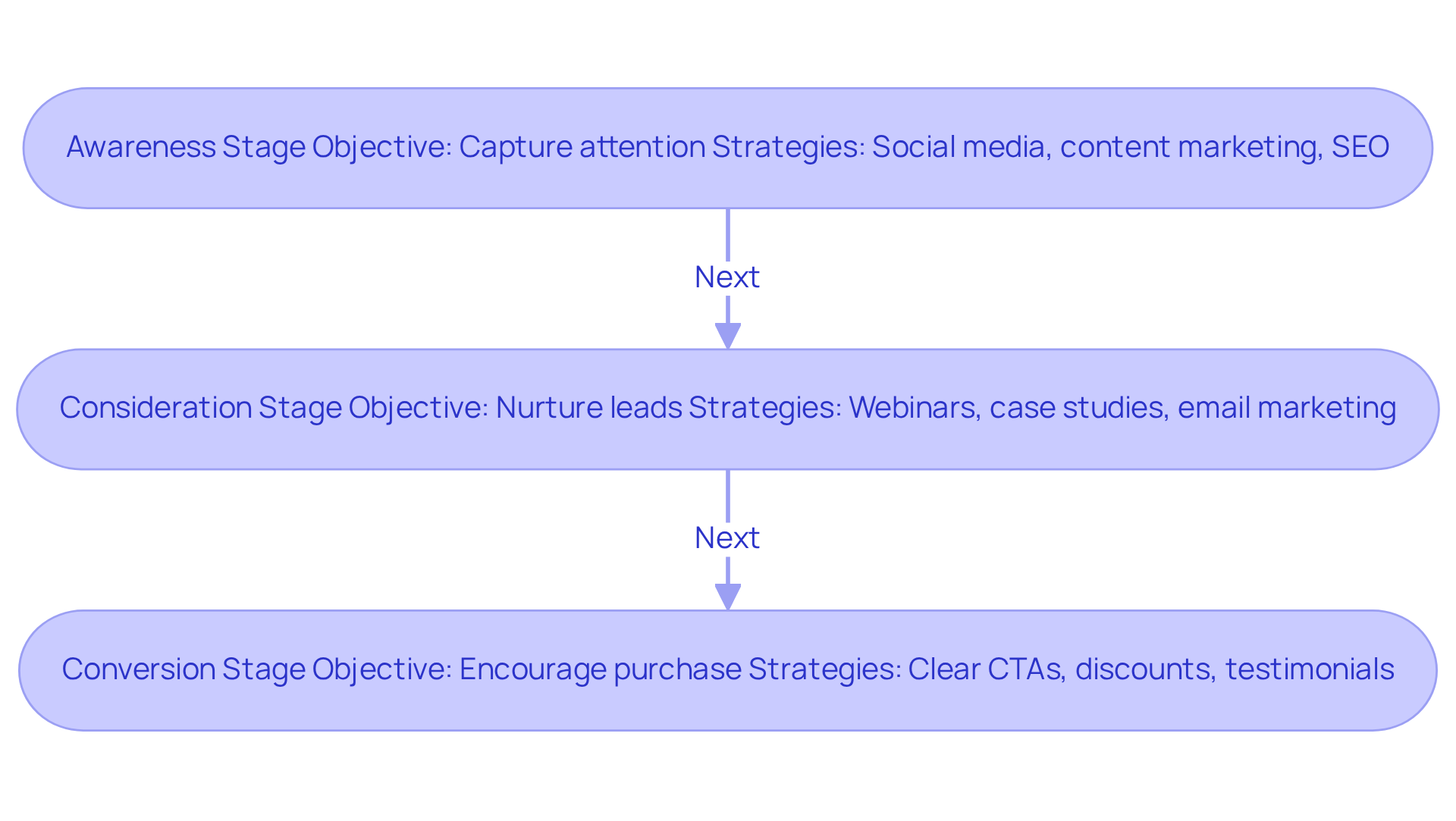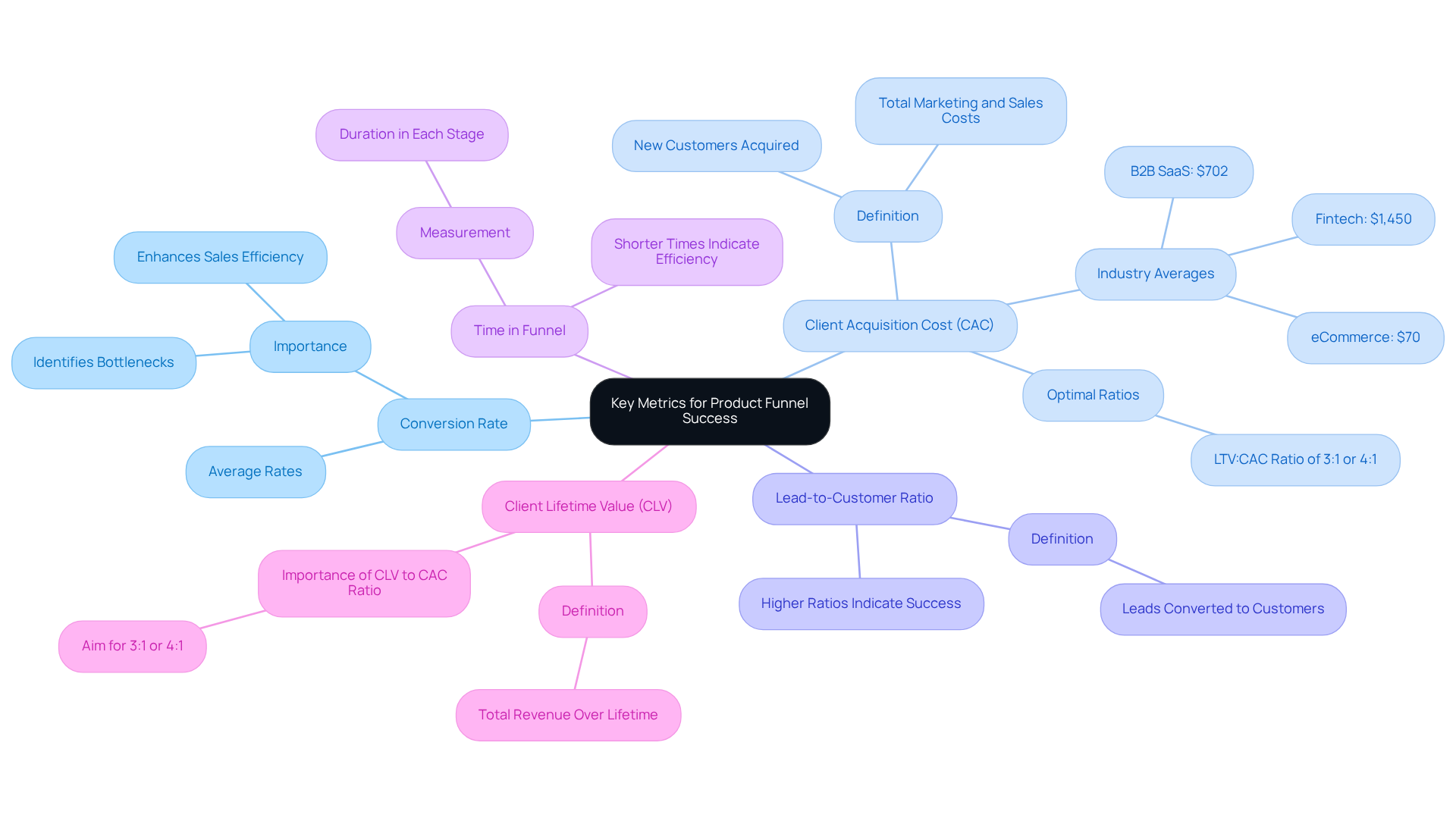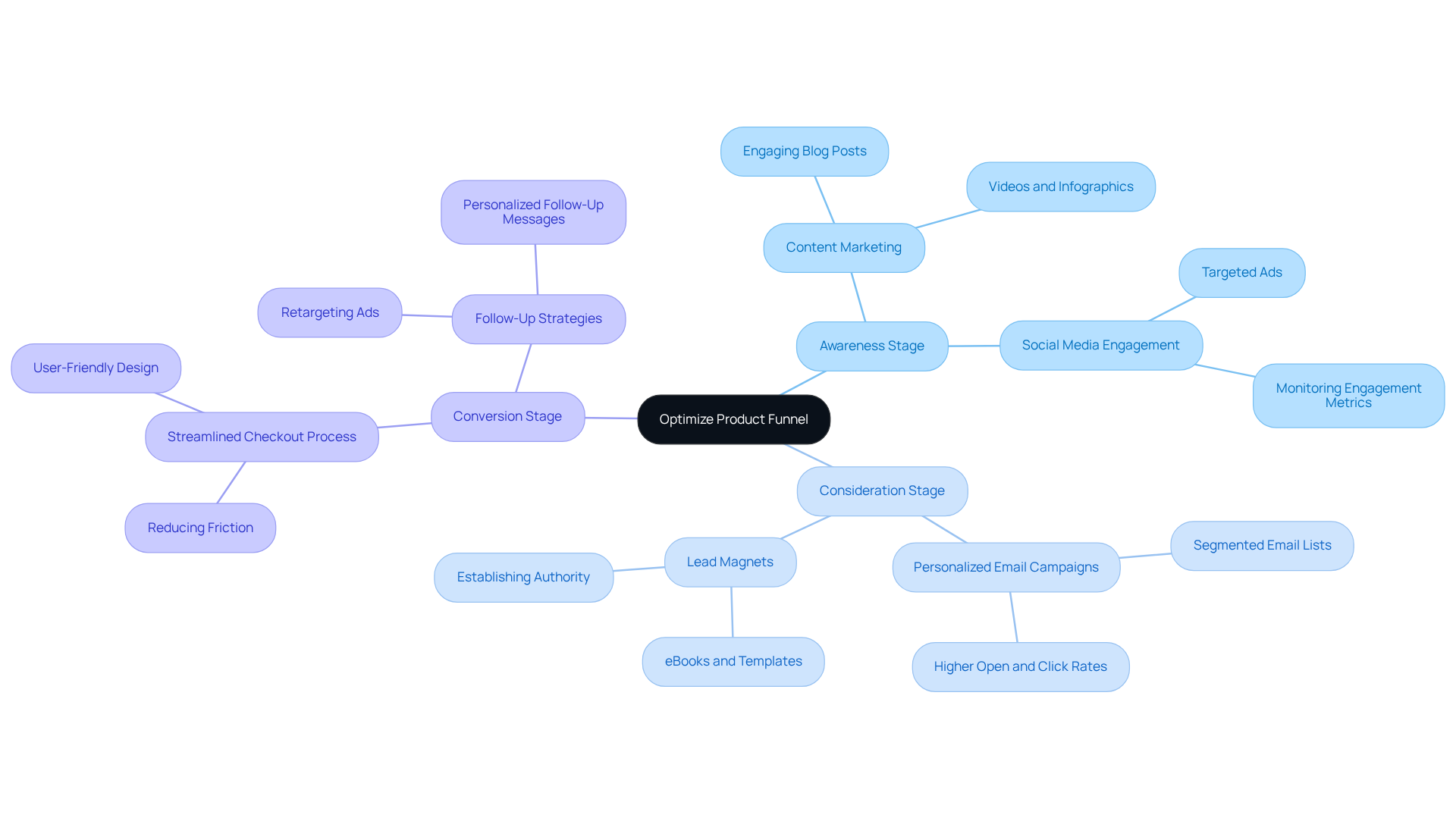Overview
This article provides a compassionate step-by-step guide for small businesses looking to master their product funnel. It’s essential to understand the buyer's journey, from the moment potential customers become aware of your brand to the point of conversion. By identifying your target audience and defining the stages of your funnel, you can implement tailored strategies that genuinely enhance customer engagement and increase conversions. Remember, utilizing key performance metrics will help you assess the effectiveness of your efforts.
As we navigate this journey together, consider how these strategies can alleviate some of your concerns. What challenges do you face in connecting with your audience? By addressing these pain points, we can foster a deeper understanding of your customers' needs. Each phase of the funnel presents an opportunity to nurture relationships and guide potential buyers toward making informed decisions.
Ultimately, our goal is to empower you to take action. With a clear understanding of your audience and a well-defined funnel, you can create a more engaging experience for your customers. Let’s work together to achieve success in your business, ensuring that every step of the buyer’s journey is meaningful and effective.
Introduction
Understanding the intricacies of a product funnel can truly be a game-changer for small businesses looking to enhance their sales strategies. By thoughtfully mapping out the buyer's journey—from that first spark of awareness to the moment of conversion—businesses can pinpoint crucial touchpoints that either engage or alienate potential customers.
However, many entrepreneurs find themselves grappling with how to define and optimize these stages. They may wonder: what are the best practices to ensure no lead falls through the cracks?
This guide offers actionable steps to master the product funnel, empowering small businesses to not only drive conversions but also foster lasting customer relationships. Together, we can navigate this journey, ensuring that every potential customer feels valued and understood.
Define Your Product Funnel: Understanding the Basics
A product funnel visually illustrates the journey a buyer experiences from discovering your product to completing a purchase. This process generally includes multiple steps, each representing a unique phase in the buyer's decision-making journey. Understanding this channel is essential for pinpointing possible drop-off points and applying methods to sustain customer engagement. By defining your product funnel with stages such as Awareness, Consideration, and Conversion, you establish a roadmap for your sales strategy that effectively guides your outreach efforts.
Steps to Define Your Product Funnel:
-
Identify Your Target Audience: Who are your ideal clients? Understanding their specific issues and how your product resolves them is crucial. As Peter Drucker wisely noted, 'Quality in a service or product is not what you invest into it; it is what the client derives from it.' Reflect on how your offering meets their needs.
-
Outline the phases of your product funnel: Clearly defining the phases ensures each step accurately represents a part of the buyer's journey. This clarity allows you to anticipate customer needs at every stage, fostering a more personalized experience.
-
Visualize the product funnel by creating a diagram that depicts the phases. This visual representation facilitates easier communication of your plan to your team, enhancing understanding and alignment.
-
Set Goals for Each Stage: What does success look like at each phase? Defining metrics, such as the number of leads generated or conversions achieved, helps you measure effectiveness and adjust strategies as needed.
By mastering your product flow, you can create a more engaging customer journey that ultimately leads to increased conversions and customer loyalty. Together, we can achieve success in nurturing your audience's experience.

Identify the Stages of Your Product Funnel: Awareness, Consideration, and Conversion
The product funnel is made up of three essential phases: Awareness, Consideration, and Conversion. Each phase of the product funnel requires tailored strategies to gently guide prospects toward making a purchase.
Awareness Stage:
- Objective: Capture the attention of potential customers who may be feeling overwhelmed.
- Strategies: We can utilize social media, content marketing, and SEO to enhance visibility. Creating engaging content that addresses common pain points not only draws in potential customers but also shows that we understand their struggles.
Consideration Stage:
- Objective: Nurture leads by providing them with valuable information that resonates with their needs.
- Strategies: Offering webinars, case studies, and detailed product descriptions can be incredibly helpful. Additionally, using email marketing to keep prospects informed and engaged fosters a supportive relationship.
Conversion Stage:
- Objective: Encourage prospects to take that important step toward making a purchase.
- Strategies: Implementing clear calls-to-action (CTAs), offering limited-time discounts, and providing testimonials can build trust. It’s crucial to ensure that the purchasing process is seamless and user-friendly, making it easier for them to say yes.

Measure Success: Key Metrics for Your Product Funnel
To effectively assess the success of your product process, it's important to focus on key performance indicators (KPIs) that reflect the condition of each phase. By doing so, you can gain valuable insights into your operations and make informed decisions. Let’s explore some essential metrics to track:
- Conversion Rate: This metric shows the percentage of leads that move from one stage to the next, helping you identify potential bottlenecks in your funnel. A well-optimized conversion rate can significantly enhance your sales efficiency, making it a crucial area to monitor.
- Client Acquisition Cost (CAC): This represents the total expense incurred to acquire a new client, encompassing all marketing and sales costs. For small businesses, it's vital to maintain a CAC that is considerably lower than the lifetime value (CLV) to ensure profitability. The average CAC varies by industry; for instance, eCommerce businesses average around $70, while B2B companies typically face higher costs, averaging $536. If your costs to acquire a client exceed what you can earn from them, it’s a clear signal that your strategy needs prompt adjustment.
- Lead-to-Customer Ratio: This metric reveals how many leads convert into paying customers, offering insight into the effectiveness of your sales process. A higher ratio indicates a more successful process, which can lead to greater satisfaction for both you and your clients.
- Time in Funnel: Consider measuring how long leads stay in each stage of the funnel. A shorter duration often signifies a more efficient process, allowing for quicker conversions and reduced costs.
- Client Lifetime Value (CLV): Understanding the total revenue generated by an individual over their lifetime is essential for evaluating the long-term value of your acquisition strategies. A favorable CLV to CAC ratio is typically around 3:1 or 4:1, ensuring that the revenue from clients surpasses the expenses involved in acquiring them.
Additionally, think about implementing referral programs. These can significantly lower your CAC by leveraging satisfied customers to generate new leads. Customized onboarding experiences can also enhance user retention and further reduce CAC, making them valuable strategies for small business owners like yourself.
By concentrating on these essential metrics and approaches, you can gain valuable insights into your product pathways, enhance your sales procedures, and ultimately foster growth. Together, we can navigate these challenges and achieve success in your business journey.

Implement Strategies: Optimize Each Stage of Your Product Funnel
Enhancing your product funnel at each phase requires thoughtful strategies that cater to the unique needs of your prospects. Here’s how we can work together to enhance each stage:
Awareness Stage Optimization:
- Content Marketing: Create engaging blog posts, videos, and infographics that address the common questions and pain points of your target audience. This approach not only builds brand awareness but also positions your business as a trusted resource. By utilizing Wayy.ai's insights, you can tailor your content to resonate with the interests of your audience.
- Social Media Engagement: Engage actively with your audience on the platforms where they spend their time. Use targeted ads to connect with potential clients effectively, ensuring your message aligns with their interests. Wayy.ai can help you monitor engagement metrics to refine your social media strategy.
Consideration Stage Optimization:
- Personalized Email Campaigns: Segment your email list to deliver tailored content that speaks directly to each group's interests. Personalized emails can significantly boost engagement, as studies show they achieve higher open and click-through rates compared to generic messages. In fact, personalized emails generate a median ROI of 122%. Leverage Wayy.ai's daily email updates to track your campaigns' effectiveness.
- Lead Magnets: Offer valuable resources, such as eBooks or templates, in exchange for contact information. This not only nurtures leads but also establishes your authority in the industry.
Conversion Stage Optimization:
- Streamlined Checkout Process: Simplify your purchasing process to ensure it is intuitive and user-friendly, reducing friction for customers. A seamless experience can lead to higher conversion rates.
- Follow-Up Strategies: After a lead shows interest, follow up with personalized messages encouraging them to complete their purchase. Consider using retargeting ads to remind them of their interest, as this can significantly enhance conversion rates. Utilize Wayy.ai's daily email updates to monitor key metrics, such as the number of leads reached, who expressed interest, and the conversion rate, enabling you to refine your follow-up strategies effectively.
By implementing these strategies, small businesses can compassionately guide prospects through the product funnel, enhancing engagement and driving sales together.

Conclusion
Mastering the product funnel is essential for small businesses looking to enhance their sales processes and customer engagement. By understanding and implementing the various stages of the product funnel—Awareness, Consideration, and Conversion—you can effectively guide potential customers through their purchasing journey. This structured approach not only helps identify drop-off points but also fosters a more personalized experience, ultimately leading to increased conversions and customer loyalty.
This article outlines essential steps to define and optimize your product funnel. It begins with identifying your target audience and clearly outlining the phases of the funnel. Each stage requires tailored strategies:
- Capturing attention during the Awareness phase
- Nurturing leads in the Consideration stage
- Facilitating seamless conversions
Key performance indicators, such as conversion rates and client acquisition costs, are vital metrics for measuring success and refining your strategies.
In conclusion, the importance of mastering the product funnel cannot be overstated. By focusing on the unique needs of prospects at each stage and utilizing effective strategies, you can create a more engaging and efficient customer journey. Embracing these practices not only enhances your sales processes but also builds lasting relationships with customers, paving the way for sustainable growth. We encourage you to take action now, optimizing your product funnels to achieve greater success and satisfaction in your business endeavors.
Frequently Asked Questions
What is a product funnel?
A product funnel visually illustrates the journey a buyer experiences from discovering a product to completing a purchase, including multiple steps that represent different phases in the buyer's decision-making journey.
Why is understanding the product funnel important?
Understanding the product funnel is essential for identifying potential drop-off points and applying methods to sustain customer engagement throughout the buying process.
What are the key stages of a product funnel?
The key stages of a product funnel typically include Awareness, Consideration, and Conversion, which establish a roadmap for a sales strategy and guide outreach efforts.
How can I identify my target audience for the product funnel?
Identifying your target audience involves understanding who your ideal clients are and how your product resolves their specific issues, ensuring that your offering meets their needs.
What should I do to outline the phases of my product funnel?
Clearly defining the phases of your product funnel ensures that each step accurately represents a part of the buyer's journey, allowing you to anticipate customer needs at every stage for a more personalized experience.
How can I visualize my product funnel?
You can visualize your product funnel by creating a diagram that depicts the phases, which facilitates easier communication of your plan to your team and enhances understanding and alignment.
Why is it important to set goals for each stage of the product funnel?
Setting goals for each stage helps define what success looks like, allowing you to measure effectiveness through metrics such as the number of leads generated or conversions achieved, and adjust strategies as needed.
What is the ultimate benefit of mastering your product funnel?
Mastering your product funnel creates a more engaging customer journey that leads to increased conversions and customer loyalty.




